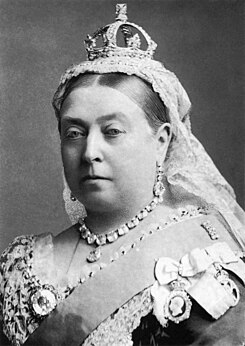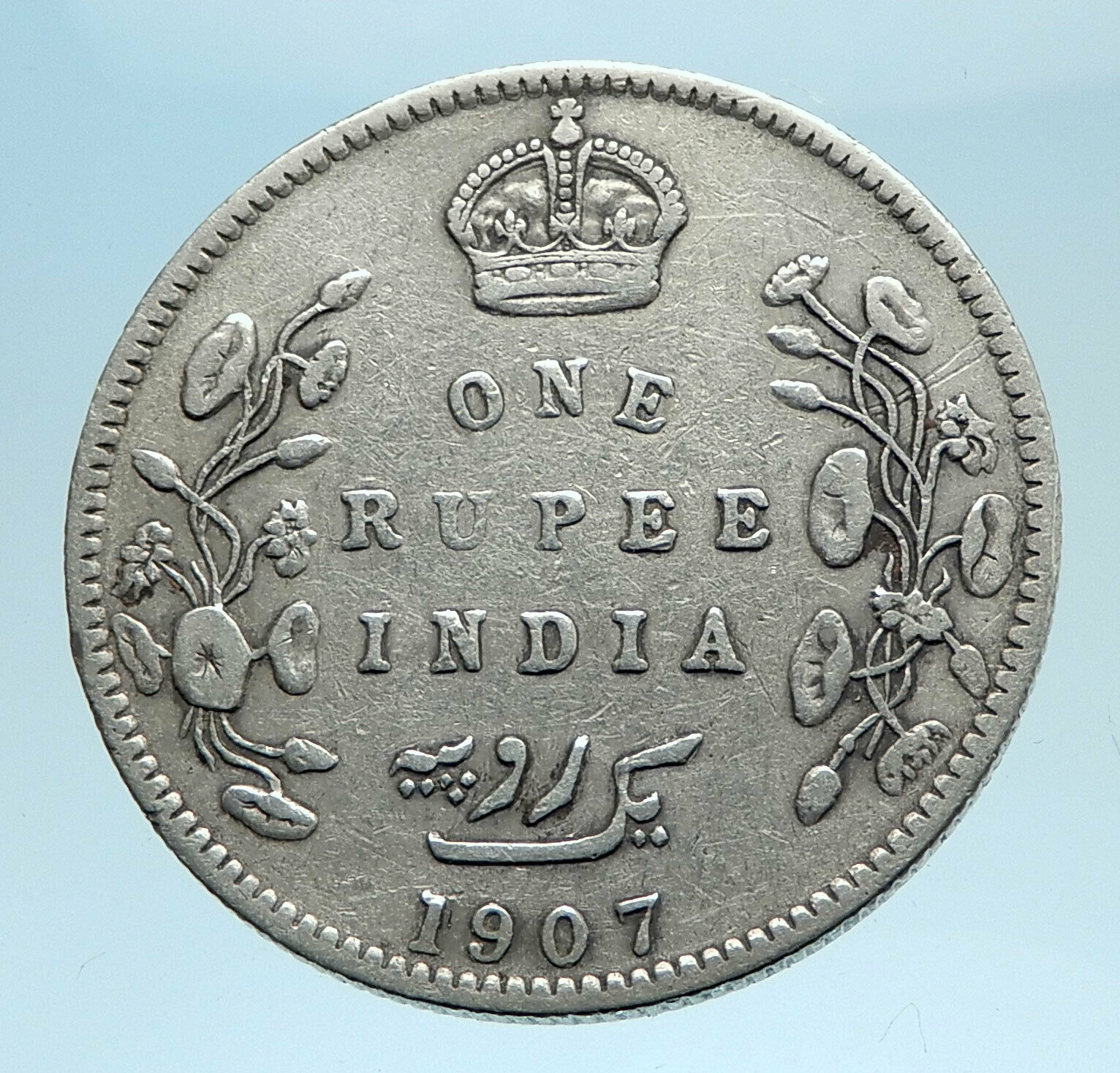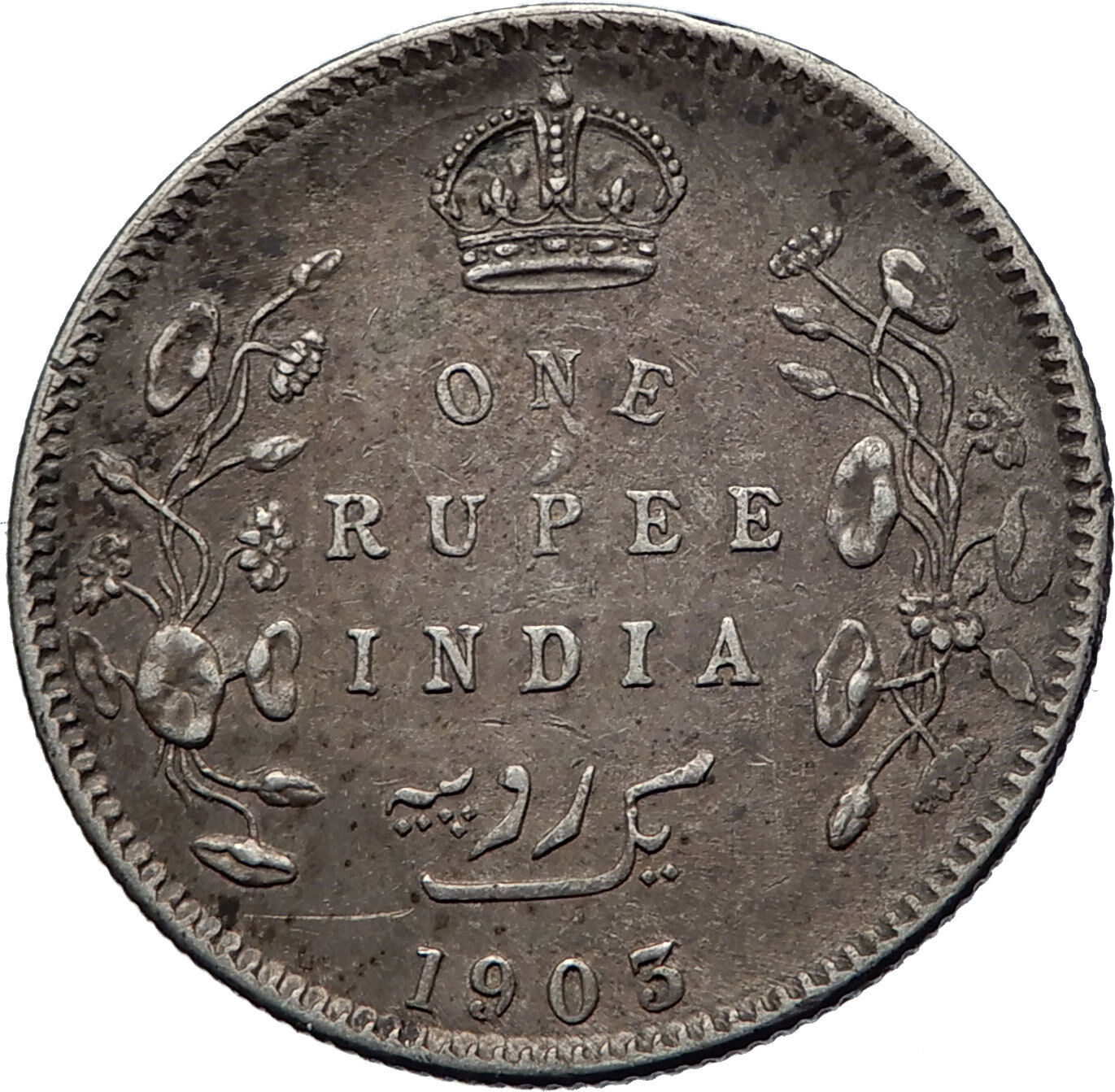|
British India under Victoria – Queen: 20 June 1837 – 22 January 1901
1862 C Silver 1/4 Rupee 19mm (2.84 grams) 0.917 Silver (0.0861 oz. ASW)
Reference: KM# 470 (1862-76) | Engraver: William Wyon
VICTORIA QUEEN, Head of Queen Victoria facing left, Divided legend in English, toothed rim.
1/4 RUPEE INDIA 1862, Wreath around inscription.
You are bidding on the exact item pictured, provided with a Certificate of Authenticity and Lifetime Guarantee of Authenticity.
 Victoria (Alexandrina Victoria; 24 May 1819 – 22 January 1901) was Queen of the United Kingdom of Great Britain and Ireland from 20 June 1837 until her death. From 1 May 1876, she had the additional title of Empress of India. Victoria (Alexandrina Victoria; 24 May 1819 – 22 January 1901) was Queen of the United Kingdom of Great Britain and Ireland from 20 June 1837 until her death. From 1 May 1876, she had the additional title of Empress of India.
Victoria was the daughter of Prince Edward, Duke of Kent and Strathearn, the fourth son of King George III. Both the Duke of Kent and King George III died in 1820, and Victoria was raised under close supervision by her German-born mother Princess Victoria of Saxe-Coburg-Saalfeld. She inherited the throne aged 18, after her father’s three elder brothers had all died, leaving no surviving legitimate children. The United Kingdom was already an established constitutional monarchy, in which the sovereign held relatively little direct political power. Privately, Victoria attempted to influence government policy and ministerial appointments; publicly, she became a national icon who was identified with strict standards of personal morality.
Victoria married her first cousin, Prince Albert of Saxe-Coburg and Gotha, in 1840. Their nine children married into royal and noble families across the continent, tying them together and earning her the sobriquet “the grandmother of Europe”. After Albert’s death in 1861, Victoria plunged into deep mourning and avoided public appearances. As a result of her seclusion, republicanism temporarily gained strength, but in the latter half of her reign her popularity recovered. Her Golden and Diamond Jubilees were times of public celebration.
Her reign of 63 years and seven months is known as the Victorian era. It was a period of industrial, cultural, political, scientific, and military change within the United Kingdom, and was marked by a great expansion of the British Empire. She was the last British monarch of the House of Hanover. Her son and successor, Edward VII, belonged to the House of Saxe-Coburg and Gotha, the line of his father.
 The State of India (Portuguese: Estado da Índia), also referred as the Portuguese State of India (Estado Português da Índia, EPI) or simply Portuguese India (Índia Portuguesa), was a state of the Portuguese Overseas Empire, founded six years after the discovery of a sea route between Portugal and the Indian Subcontinent to serve as the governing body of a string of Portuguese fortresses and colonies overseas. The State of India (Portuguese: Estado da Índia), also referred as the Portuguese State of India (Estado Português da Índia, EPI) or simply Portuguese India (Índia Portuguesa), was a state of the Portuguese Overseas Empire, founded six years after the discovery of a sea route between Portugal and the Indian Subcontinent to serve as the governing body of a string of Portuguese fortresses and colonies overseas.
The first viceroy, Francisco de Almeida, established his headquarters in Cochin (Cochim, Kochi). Subsequent Portuguese governors were not always of viceroy rank. After 1510, the capital of the Portuguese viceroyalty was transferred to Goa.[1] Until the 18th century, the Portuguese governor in Goa had authority over all Portuguese possessions in the Indian Ocean, from southern Africa to southeast Asia. In 1752 Mozambique got its own separate government and in 1844 the Portuguese Government of India stopped administering the territory of Macau, Solor and Timor, and its authority was confined to the colonial holdings on the Malabar coast of present-day India.
.svg/85px-Coat_of_arms_of_Portuguese_India_(1951-1974).svg.png) At the time of the British Indian Empire’s dissolution in 1947, Portuguese India was subdivided into three districts located on modern-day India’s western coast, sometimes referred to collectively as Goa: namely Goa; Daman (Portuguese: Damão), which included the inland enclaves of Dadra and Nagar Haveli; and Diu. Portugal lost effective control of the enclaves of Dadra and Nagar Haveli in 1954, and finally the rest of the overseas territory in December 1961, when it was taken by India after military action. In spite of this, Portugal only recognised Indian control in 1975, after the Carnation Revolution and the fall of the Estado Novo regime. At the time of the British Indian Empire’s dissolution in 1947, Portuguese India was subdivided into three districts located on modern-day India’s western coast, sometimes referred to collectively as Goa: namely Goa; Daman (Portuguese: Damão), which included the inland enclaves of Dadra and Nagar Haveli; and Diu. Portugal lost effective control of the enclaves of Dadra and Nagar Haveli in 1954, and finally the rest of the overseas territory in December 1961, when it was taken by India after military action. In spite of this, Portugal only recognised Indian control in 1975, after the Carnation Revolution and the fall of the Estado Novo regime.
In the year 1509, Afonso de Albuquerque was appointed the second governor of the Portuguese possessions in the East. A new fleet under Marshal Fernão Coutinho arrived with specific instructions to destroy the power of Zamorin’s of Calicut. The Zamorin’s palace was captured and destroyed and the city was set on fire. The king’s forces rallied to kill Coutinho and wound Albuquerque. Albuquerque relented, and entered into a treaty with the Zamorin in 1513 to protect Portuguese interests in Malabar. Hostilities were renewed when the Portuguese attempted to assassinate the Zamorin sometime between 1515 and 1518. In 1510, Afonso de Albuquerque defeated the Bijapur sultans with the help of Timayya, on behalf of the Hindu Vijayanagara Empire, leading to the establishment of a permanent settlement in Velha Goa (or Old Goa). The Southern Province, also known simply as Goa, was the headquarters of Portuguese India, and seat of the Portuguese viceroy who governed the Portuguese possessions in Asia.
 There were Portuguese settlements in and around Mylapore. The Luz Church in Mylapore, Madras (Chennai) was the first church that the Portuguese built in Madras in 1516. Later in 1522, the São Tomé church was built by the Portuguese. They had also looted the treasures and destroyed the original Kapaleeswarar Temple. There were Portuguese settlements in and around Mylapore. The Luz Church in Mylapore, Madras (Chennai) was the first church that the Portuguese built in Madras in 1516. Later in 1522, the São Tomé church was built by the Portuguese. They had also looted the treasures and destroyed the original Kapaleeswarar Temple.
The Portuguese acquired several territories from the Sultans of Gujarat: Daman (occupied 1531, formally ceded 1539); Salsette, Bombay, and Baçaim (occupied 1534); and Diu (ceded 1535).
These possessions became the Northern Province of Portuguese India, which extended almost 100 km along the coast from Daman to Chaul, and in places 30-50 km inland. The province was ruled from the fortress-town of Baçaim.
In 1526, under the viceroyship of Lopo Vaz de Sampaio, the Portuguese took possession of Mangalore. The territory included parts of Dakshina Kannada and Udupi in Karnataka state, and Kasaragod in Kerala state (South Canara). Mangalore was named the islands of O Padrão de Santa Maria; later came to be known as St. Mary’s Islands. In 1640, the Keladi Nayaka Kingdom defeated the Portuguese. Shivappa Nayaka destroyed the Portuguese political power in the Kanara region by capturing all the Portuguese forts of the coastal region.
Bombay (present-day Mumbai) was given to Britain in 1661 as part of the Portuguese Princess Catherine of Braganza’s dowry to Charles II of England. Most of the Northern Province was lost to the Marathas of the Maratha Empire in 1739 when the Maratha General Chimnaji Appa defeated the Portuguese. Later Portugal acquired Dadra and Nagar Haveli in 1779.
Goa was briefly occupied by the British from 1799 to 1813.
In 1843 the capital was shifted to Panjim, then renamed Nova Goa, when it officially became the administrative seat of Portuguese India, replacing the city of Velha Goa (now Old Goa), although the Viceroys lived there already since 1 December 1759. Before moving to the city, the viceroy remodelled the fortress of Adil khan, transforming it into a palace.
The Portuguese also shipped over many Órfãs d’El-Rei to Portuguese colonies in the Indian peninsula, Goa in particular. Órfãs d’El-Rei literally translates to Orphans of the King, and they were Portuguese girl orphans sent to overseas colonies to marry either Portuguese settlers or natives with high status.
Thus there are Portuguese footprints all over the western and eastern coasts of the Indian peninsula, though Goa became the capital of Portuguese Goa from 1530 onward until the annexation of Goa proper and the entire Estado da Índia Portuguesa, and its merger with the Indian Union in 1961.
.svg/220px-Great_Britain_(orthographic_projection).svg.png) Great Britain, also known as Britain, is an island in the North Atlantic off the north-west coast of continental Europe. With an area of 209,331 km2 (80,823 sq mi), it is the largest island in Europe and the ninth-largest in the world. In 2011 the island had a population of about 61 million people, making it the third-most populous island in the world, after Java in Indonesia and Honshu in Japan. The island is the largest in the British Isles archipelago, which also includes the island of Ireland to its west and over 1,000 smaller surrounding islands. Great Britain, also known as Britain, is an island in the North Atlantic off the north-west coast of continental Europe. With an area of 209,331 km2 (80,823 sq mi), it is the largest island in Europe and the ninth-largest in the world. In 2011 the island had a population of about 61 million people, making it the third-most populous island in the world, after Java in Indonesia and Honshu in Japan. The island is the largest in the British Isles archipelago, which also includes the island of Ireland to its west and over 1,000 smaller surrounding islands.
The island is dominated by an oceanic climate with quite narrow temperature differences between seasons. Politically, the island is part of the United Kingdom of Great Britain and Northern Ireland, constituting most of its territory: most of England, Scotland, and Wales are on the island, with their respective capital cities, London, Edinburgh, and Cardiff. The term Great Britain often extends to include surrounding islands that form part of England, Scotland, and Wales.
A single Kingdom of Great Britain resulted from the Union of Scotland and England (which already comprised the present-day countries of England and Wales) in 1707. More than a hundred years before, in 1603, King James VI, King of Scots, had inherited the throne of England, but it was not until 1707 that the Parliaments of the two countries agreed to form a unified state. In 1801, Great Britain united with the neighboring Kingdom of Ireland, forming the United Kingdom of Great Britain and Ireland, which was renamed the United Kingdom of Great Britain and Northern Ireland after the Irish Free State seceded in 1922.
|





 Victoria (Alexandrina Victoria; 24 May 1819 – 22 January 1901) was Queen of the United Kingdom of Great Britain and Ireland from 20 June 1837 until her death. From 1 May 1876, she had the additional title of Empress of India.
Victoria (Alexandrina Victoria; 24 May 1819 – 22 January 1901) was Queen of the United Kingdom of Great Britain and Ireland from 20 June 1837 until her death. From 1 May 1876, she had the additional title of Empress of India. The State of India (Portuguese: Estado da Índia), also referred as the Portuguese State of India (Estado Português da Índia, EPI) or simply Portuguese India (Índia Portuguesa), was a state of the Portuguese Overseas Empire, founded six years after the discovery of a sea route between Portugal and the Indian Subcontinent to serve as the governing body of a string of Portuguese fortresses and colonies overseas.
The State of India (Portuguese: Estado da Índia), also referred as the Portuguese State of India (Estado Português da Índia, EPI) or simply Portuguese India (Índia Portuguesa), was a state of the Portuguese Overseas Empire, founded six years after the discovery of a sea route between Portugal and the Indian Subcontinent to serve as the governing body of a string of Portuguese fortresses and colonies overseas. .svg/85px-Coat_of_arms_of_Portuguese_India_(1951-1974).svg.png) At the time of the British Indian Empire’s dissolution in 1947, Portuguese India was subdivided into three districts located on modern-day India’s western coast, sometimes referred to collectively as Goa: namely Goa; Daman (Portuguese: Damão), which included the inland enclaves of Dadra and Nagar Haveli; and Diu. Portugal lost effective control of the enclaves of Dadra and Nagar Haveli in 1954, and finally the rest of the overseas territory in December 1961, when it was taken by India after military action. In spite of this, Portugal only recognised Indian control in 1975, after the Carnation Revolution and the fall of the Estado Novo regime.
At the time of the British Indian Empire’s dissolution in 1947, Portuguese India was subdivided into three districts located on modern-day India’s western coast, sometimes referred to collectively as Goa: namely Goa; Daman (Portuguese: Damão), which included the inland enclaves of Dadra and Nagar Haveli; and Diu. Portugal lost effective control of the enclaves of Dadra and Nagar Haveli in 1954, and finally the rest of the overseas territory in December 1961, when it was taken by India after military action. In spite of this, Portugal only recognised Indian control in 1975, after the Carnation Revolution and the fall of the Estado Novo regime.  There were Portuguese settlements in and around Mylapore. The Luz Church in Mylapore, Madras (Chennai) was the first church that the Portuguese built in Madras in 1516. Later in 1522, the São Tomé church was built by the Portuguese. They had also looted the treasures and destroyed the original Kapaleeswarar Temple.
There were Portuguese settlements in and around Mylapore. The Luz Church in Mylapore, Madras (Chennai) was the first church that the Portuguese built in Madras in 1516. Later in 1522, the São Tomé church was built by the Portuguese. They had also looted the treasures and destroyed the original Kapaleeswarar Temple. .svg/220px-Great_Britain_(orthographic_projection).svg.png) Great Britain, also known as Britain, is an island in the North Atlantic off the north-west coast of continental Europe. With an area of 209,331 km2 (80,823 sq mi), it is the largest island in Europe and the ninth-largest in the world. In 2011 the island had a population of about 61 million people, making it the third-most populous island in the world, after Java in Indonesia and Honshu in Japan. The island is the largest in the British Isles archipelago, which also includes the island of Ireland to its west and over 1,000 smaller surrounding islands.
Great Britain, also known as Britain, is an island in the North Atlantic off the north-west coast of continental Europe. With an area of 209,331 km2 (80,823 sq mi), it is the largest island in Europe and the ninth-largest in the world. In 2011 the island had a population of about 61 million people, making it the third-most populous island in the world, after Java in Indonesia and Honshu in Japan. The island is the largest in the British Isles archipelago, which also includes the island of Ireland to its west and over 1,000 smaller surrounding islands.




